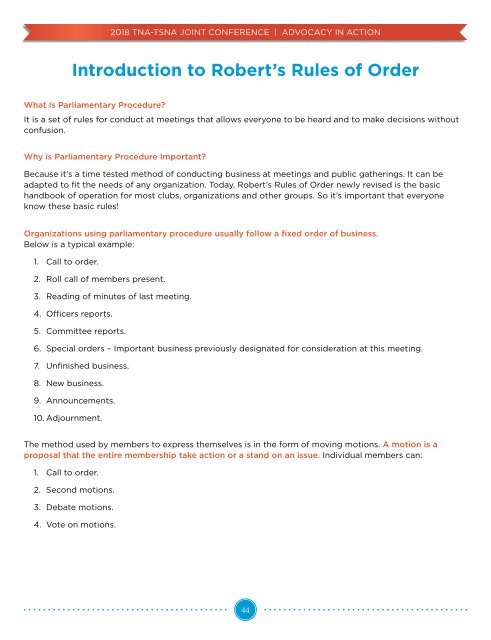2018 TNA and TSNA Joint Annual Conference
You also want an ePaper? Increase the reach of your titles
YUMPU automatically turns print PDFs into web optimized ePapers that Google loves.
<strong>2018</strong> <strong>TNA</strong>-<strong>TSNA</strong> JOINT CONFERENCE | ADVOCACY IN ACTION<br />
Introduction to Robert’s Rules of Order<br />
What Is Parliamentary Procedure?<br />
It is a set of rules for conduct at meetings that allows everyone to be heard <strong>and</strong> to make decisions without<br />
confusion.<br />
Why is Parliamentary Procedure Important?<br />
Because it’s a time tested method of conducting business at meetings <strong>and</strong> public gatherings. It can be<br />
adapted to fit the needs of any organization. Today, Robert’s Rules of Order newly revised is the basic<br />
h<strong>and</strong>book of operation for most clubs, organizations <strong>and</strong> other groups. So it’s important that everyone<br />
know these basic rules!<br />
Organizations using parliamentary procedure usually follow a fixed order of business.<br />
Below is a typical example:<br />
1. Call to order.<br />
2. Roll call of members present.<br />
3. Reading of minutes of last meeting.<br />
4. Officers reports.<br />
5. Committee reports.<br />
6. Special orders – Important business previously designated for consideration at this meeting.<br />
7. Unfinished business.<br />
8. New business.<br />
9. Announcements.<br />
10. Adjournment.<br />
The method used by members to express themselves is in the form of moving motions. A motion is a<br />
proposal that the entire membership take action or a st<strong>and</strong> on an issue. Individual members can:<br />
1. Call to order.<br />
2. Second motions.<br />
3. Debate motions.<br />
4. Vote on motions.<br />
44

















